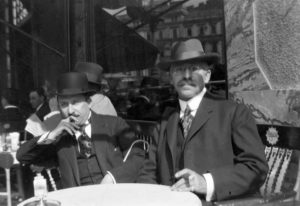
“Coffeehouse is a business space above the ground, where coffee, tea, chocolate, certain alcoholic drinks (with no permission required), and cakes used offered to consume with the above drinks; at least two normal sized pool tables are always available for the public, except Coffeehouses in the suburbs, where only one pool table is required, and finally, the business is marked as “Coffeehouse”. (Pallas Great Lexicon)
Only a reliable person could open a Coffeehouse (Kávéház) or a Coffee Shop (Kávémérés). The Coffee Shop could sell coffee, tea, milk and also patisserie products, but no music, dance, games, chessboards nor pool table, or any kind of entertainment were allowed. Strick closing hours is 11 pm, and opening is 3 am. Whilst, Coffeehouses were 24-hours businesses.
There were 64 Coffeehouses in the Great Boulevard in Budapest in 1896 (around 500 in Budapest). By the beginning of WWI only 50 survived, and by WWII we could only count 25 Coffeehouses here. Nationalization, Communist era arrived, none of them survived. Before their revival could have started, fast food chains and banks protruded the premises for unrealistic rent.
“96 marble tables, 6 double marble tables, 164 armchair, 242 chairs, 5 db 3 meter length and 2 2-meter length sofas, 67 terrace marble tables, 183 reed chairs, 3 phone booths,.. etc” List of goods taken from Café Abbázia by the nationalist brigade in the name of democracy, February 19 1949, 2 am. Work of 3 generations in 80 years. (Source: Saly Noémi: Törzskávéházamból zenés kávéházba)
